Raising a bunny as a pet can be an incredibly rewarding and fun experience for both children and adults alike. These adorable, cuddly creatures make great companions when given the proper love and care. In order to ensure your bunny is happy and healthy, it’s essential to understand their basic needs, create a comfortable habitat, select the right breed, and learn how to properly handle and socialize them. Additionally, understanding rabbit communication, maintaining a healthy diet, and providing regular grooming and healthcare will contribute to a thriving and enjoyable pet relationship.
Understanding Basic Rabbit Needs
Rabbits are cute and cuddly pets that can bring joy to your life. To raise a healthy and happy rabbit, it’s important to understand their dietary, social, and shelter needs. In terms of diet, rabbits require a balanced mix of hay, pellets, vegetables, and water. Fresh hay should make up around 70% of their diet, as it is vital for maintaining good dental and digestive health. Pellets provide important vitamins and minerals, while vegetables add variety and essential nutrients to their diet.
When it comes to social needs, rabbits are sociable animals that love to interact with their human family members. They need to be treated gently and respectfully to build trust and form a bond with you. Bunnies can also be happier in the company of other rabbits, and many rabbit owners choose to have pairs or groups of rabbits that can keep each other company. Remember that proper introductions and supervised interactions are necessary when introducing rabbits to ensure they get along well.
Rabbits require adequate shelter to thrive. An indoor rabbit cage or hutch is essential for providing a safe and comfortable environment for your furry friend. The cage should be large enough to allow your rabbit to move around freely and have separate areas for eating, sleeping, and using the restroom. It’s also essential to provide toys and hidey-holes for mental stimulation and a sense of security. Regular cleaning of the cage helps minimize odors and maintain a sanitary environment.
Being prepared to spend time providing your rabbit with proper care and daily interaction is essential for raising a healthy bunny as a pet. This includes feeding, grooming, and cleaning their living space. Rabbits can be sensitive to changes in their environment, so it’s important to keep them comfortable and familiar surroundings. By understanding and meeting the basic needs of your rabbit, you can raise a healthy and well-adjusted pet that will bring you many years of happiness and companionship.

Creating a Comfortable Habitat for Your Bunny
As a continuation of proper care, building a comfortable and safe space for your rabbit to live is crucial. Start by researching the appropriate cage size for your rabbit’s specific breed. A general rule to follow is that your bunny’s cage should be at least four times the size of their full-grown body. By providing a suitable living space, you are ensuring the long-term wellbeing and happiness of your new pet bunny.
Keeping your rabbit’s living space clean is essential. Make sure to clean their cage regularly by removing any waste, soiled bedding, and uneaten food. Also, change their bedding completely at least once a week.
Rabbits love playing and exploring, so providing them with enrichment toys and objects is essential. You can find many rabbit-safe toys in pet stores, or you can make your own using cardboard, untreated wood, or other safe materials. Always supervise your bunny when they’re playing with their toys.
To ensure your bunny stays happy and healthy, it’s crucial to maintain a comfortable environment for them. Keep their cage in a temperate area, away from direct sunlight, heaters, and air conditioners to avoid overheating or chilling. Also, make sure their habitat is secure and safe from possible dangers such as other animals or harmful objects.
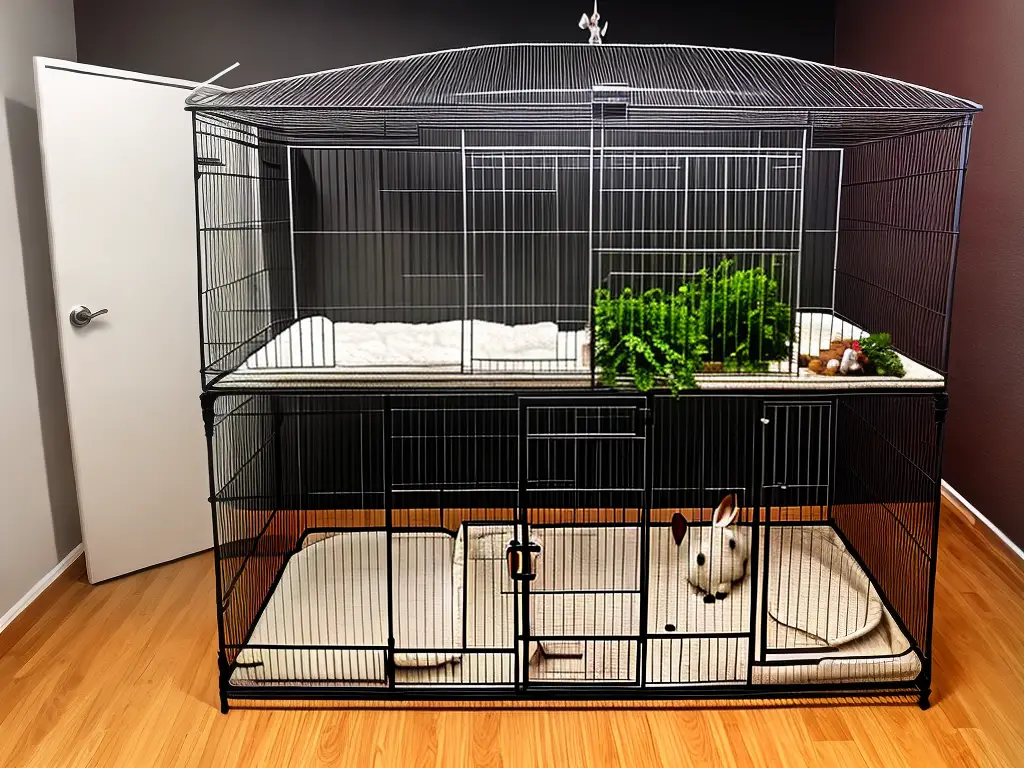
Choosing the Right Rabbit Breed for You
In choosing a bunny companion, it’s important to consider different rabbit breeds to find the best fit for your family. With over 50 unique breeds available, factors such as size, temperament, and energy levels play a significant role in determining the perfect pet. By carefully considering these characteristics, you can find a bunny well-suited as a companion for a child and an adorable addition to your household.
One popular breed for kids is the Holland Lop. These rabbits are small, usually weighing only 3-4 pounds, which makes them easy for children to handle. They are known for their sweet and friendly temperament, which is ideal for a pet. Holland Lops can be quite energetic and require plenty of playtime to stay healthy and happy. These lovable bunnies are a great choice for first-time rabbit owners, as they tend to get along well with children and other pets.
If you prefer a more calm and laid-back breed, the Mini Rex might be an excellent option. Mini Rex rabbits have a soft, plush-like fur texture which makes them lovely to pet and cuddle with. Weighing around 4-5 pounds, these rabbits are known for their gentle disposition and their ability to form strong bonds with their humans. Due to their relaxing nature, they can be the perfect companion for a quiet child who appreciates a more laid-back pet.
One small and kid-friendly rabbit breed to consider as a pet is the Netherland Dwarf. Weighing just 2-3 pounds, these tiny bunnies have big personalities. They can be quite playful, energetic, and inquisitive, making them an engaging pet for children who like to interact with their animals. Netherland Dwarfs require regular socialization and playtime, and with proper care, they can become affectionate and loyal pets for responsible children.
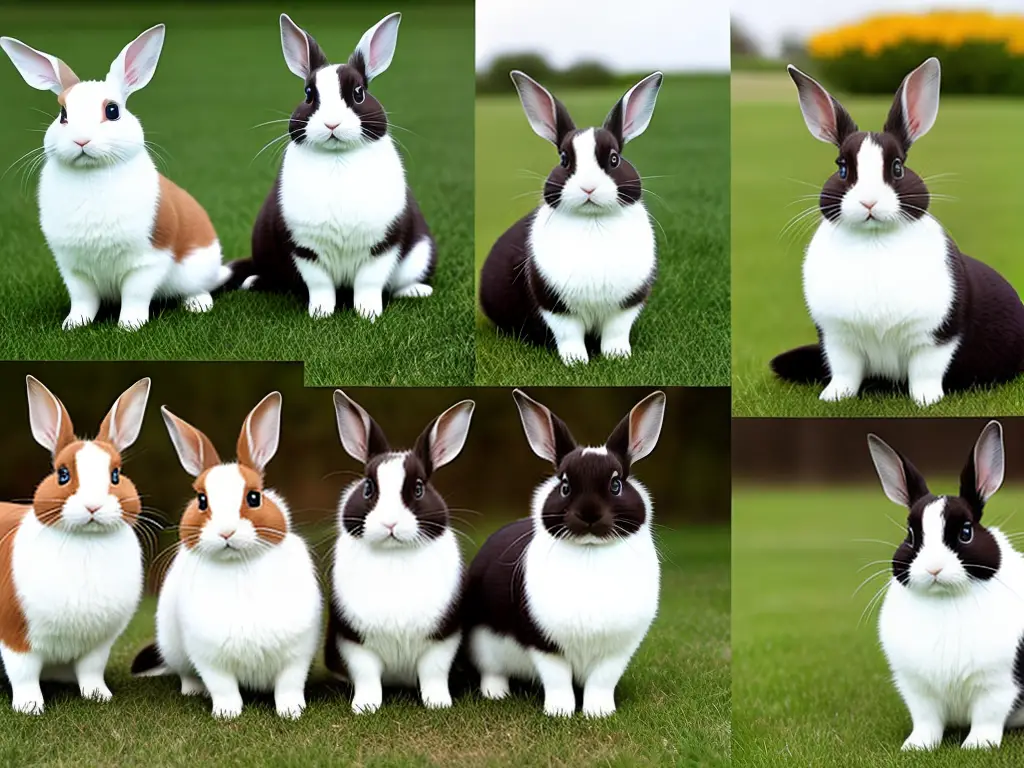
Proper Handling and Socialization of Pet Bunnies
In order to take good care of your Netherland Dwarf or any other rabbit, it’s important to learn how to handle them properly. Rabbits are delicate creatures, and proper handling is crucial for their comfort and safety. As a child, make sure you know how to pick up and hold your bunny correctly to prevent accidents or injury. To pick up a rabbit, place one hand under its chest and the other supporting its hind legs. This way, the bunny will feel secure and its spine will be supported.
Never hold a rabbit by its ears or lift it by its scruff, as this can cause pain and distress. When holding your bunny, keep it close to your body and maintain a firm, gentle grip. Rabbits can be easily startled and may try to jump out of your arms if they don’t feel secure. Always sit down or stay close to the ground when handling your bunny to reduce the risk of a fall.
Socializing your pet rabbit is an important part of raising a friendly, well-behaved bunny. By spending time interacting and playing with your rabbit, you will help it get used to human contact and feel more comfortable around people. Be sure to use gentle, calm movements when interacting with your bunny and avoid rough play or loud noises.
Handling your rabbit regularly and providing it with various toys and activities are essential for keeping it happy and stimulated. Activities such as grooming, offering treats, and allowing your pet to explore a safe environment will not only benefit their well-being but also contribute to building trust and strengthening the bond between you and your rabbit.
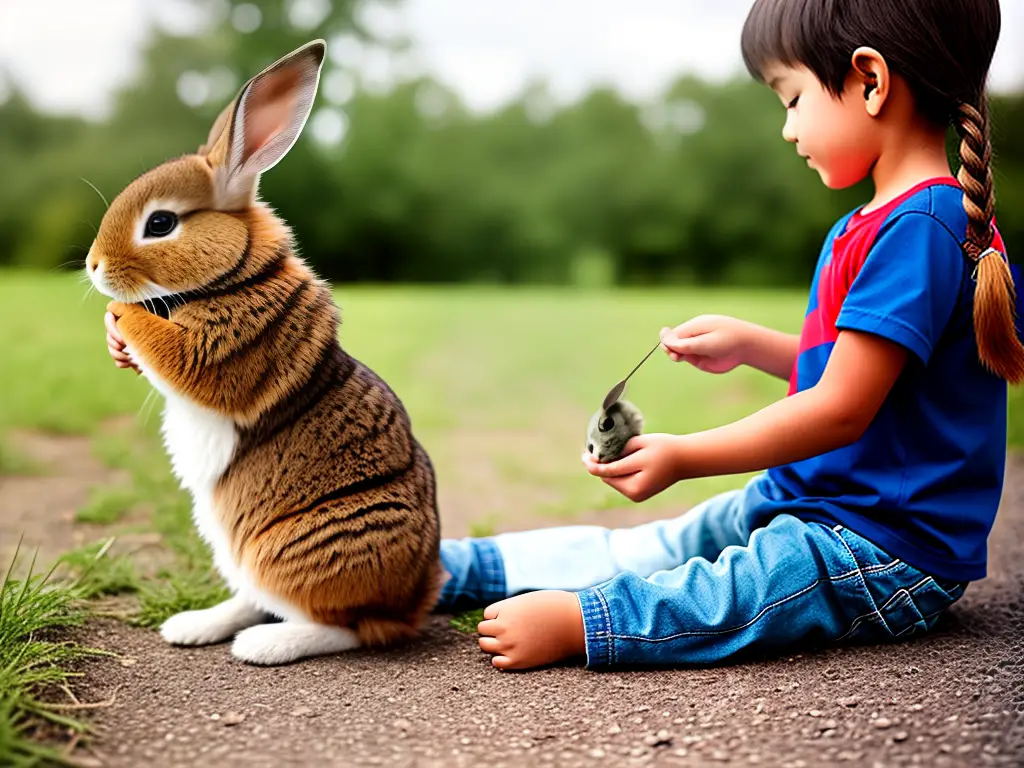
Understanding Rabbit Communication
As a pet owner, understanding your rabbit’s feelings, needs, and dispositions is crucial in maintaining a harmonious relationship. Rabbits are quite adept at communicating through their body language, which can sometimes be subtle. To better cater to their needs and create an even stronger bond, take time to observe their posture, movements, and expressions. These cues will give you invaluable insights into their emotions and overall state of mind.
One common display of rabbit body language is standing on their hind legs, which often means that they are curious and trying to get a better view of their surroundings. When happy, rabbits may perform a ‘binky,’ which is a playful jump and twist in the air. However, if your bunny is thumping its hind legs on the ground, it could indicate that they are frightened or annoyed.
Rabbits also communicate through vocalizations, although they are generally quiet animals. Soft, gentle sounds such as low humming, purring, or grinding of teeth usually mean that your rabbit is content and relaxed. On the other hand, high-pitched squeals or screams are signs of distress, and you should check on your pet immediately to ensure their wellbeing.
It is essential to familiarize yourself with various rabbit communication methods to build a strong bond with your pet, and address their needs effectively. By understanding their feelings and dispositions, you can create a loving and nurturing environment where your rabbit will thrive.
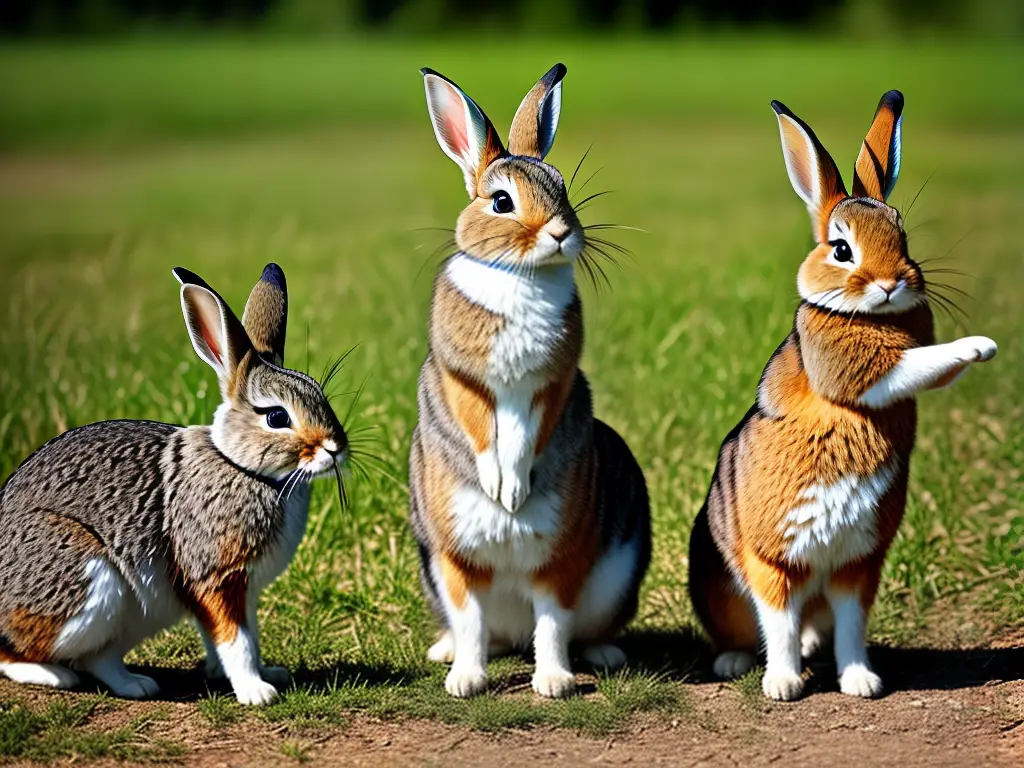
Maintaining a Healthy Diet for Your Bunny
One crucial aspect of this nurturing environment is providing a balanced diet for your bunny, which keeps them healthy, reduces the risk of illness, and promotes overall wellbeing. Hay and pellets are the primary staples of a rabbit’s diet and should always be readily available for your bunny to eat.
Hay makes up about 75% to 80% of a rabbit’s diet, as it contains essential nutrients and fiber that are vital for your rabbit’s digestive system. The best hay for your rabbit is called timothy hay, which helps maintain healthy teeth, and aids in digestion. Apart from hay, the second staple food for rabbits is pellets, which are high in nutrients and supplements designed for optimal rabbit health. However, pellets should only make up a small portion of their diet, so be sure to limit pellet consumption to around 1/8th to 1/4th of a cup of pellets per every 6 pounds of your rabbit’s weight.
In addition to hay and pellets, rabbits should also be fed a variety of fresh vegetables daily. Vegetables that are safe and healthy for your bunny include dark leafy greens, such as romaine lettuce, kale, and other greens. Aim to provide at least one cup of fresh vegetables per every 2 pounds of your rabbit’s weight. You can also treat your rabbit to small amounts of fruits, like apples, strawberries, or pears, but limit the quantity because fruits are high in sugar and should only be occasional treats for your pet.
Providing your rabbit with a healthy and balanced diet is essential for ensuring their well-being and happiness as a pet companion. Monitor your rabbit’s daily food intake and adjust their diet if necessary, and always make sure they have access to clean, fresh water at all times.
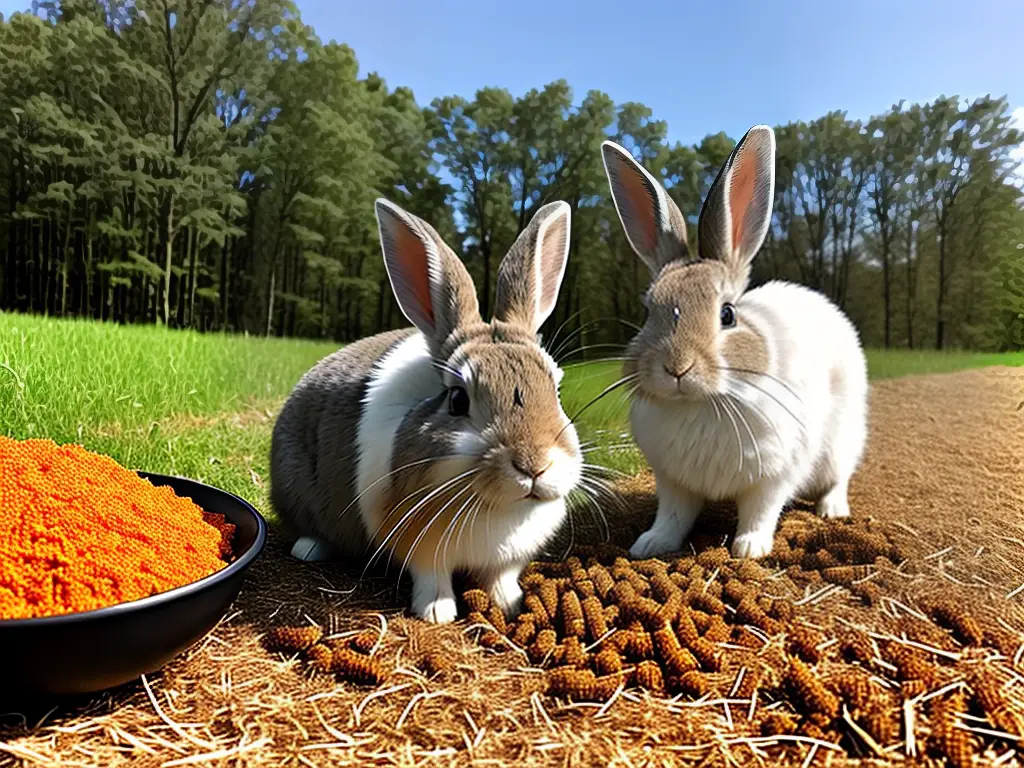
Rabbit Health Care and Grooming
In addition to a proper diet, regular grooming is crucial for maintaining your rabbit’s overall health and clean appearance. One key aspect of grooming is brushing their fur, as bunnies can accumulate hair and dirt on their coat, potentially leading to health issues if left unaddressed. Gently brush your rabbit’s fur with a soft brush at least once a week to remove loose hair and keep their coat clean and tidy. During shedding season, increase the frequency of brushing to prevent hairballs and maintain your furry pet’s cleanliness and comfort.
Another essential aspect of rabbit grooming is nail trimming. Overgrown nails can be painful and cause discomfort when your bunny is walking or hopping. To trim your rabbit’s nails, you can use a pet nail clipper or a small human nail clipper. Gently hold your rabbit and ensure they are comfortable before you start trimming their nails. Trim the sharp tip of the nail, avoiding cutting the ‘quick’ (a vein that runs through the nail). Trimming your rabbit’s nails every couple of months will maintain their comfort and prevent injuries.
Ear cleaning is also vital in keeping your bunny healthy. Regularly checking your rabbit’s ears for dirt, wax buildup, or any signs of infection is essential. Use a soft, damp cloth to clean your rabbit’s ears gently. Be careful not to insert anything into their ear canal, as it could cause damage. If you notice redness, inflammation, or a foul smell, consult a veterinarian, as it could indicate an infection or other health issues.
Being aware of the signs of illness in your rabbit is crucial for addressing potential health problems. Symptoms of a sick rabbit include lethargy, loss of appetite, hunched posture, difficulty breathing, or discharge from the eyes, nose, or mouth. Regular check-ups and consultations with your veterinarian will help you maintain your rabbit’s health and ensure a happy and safe environment for your bunny.
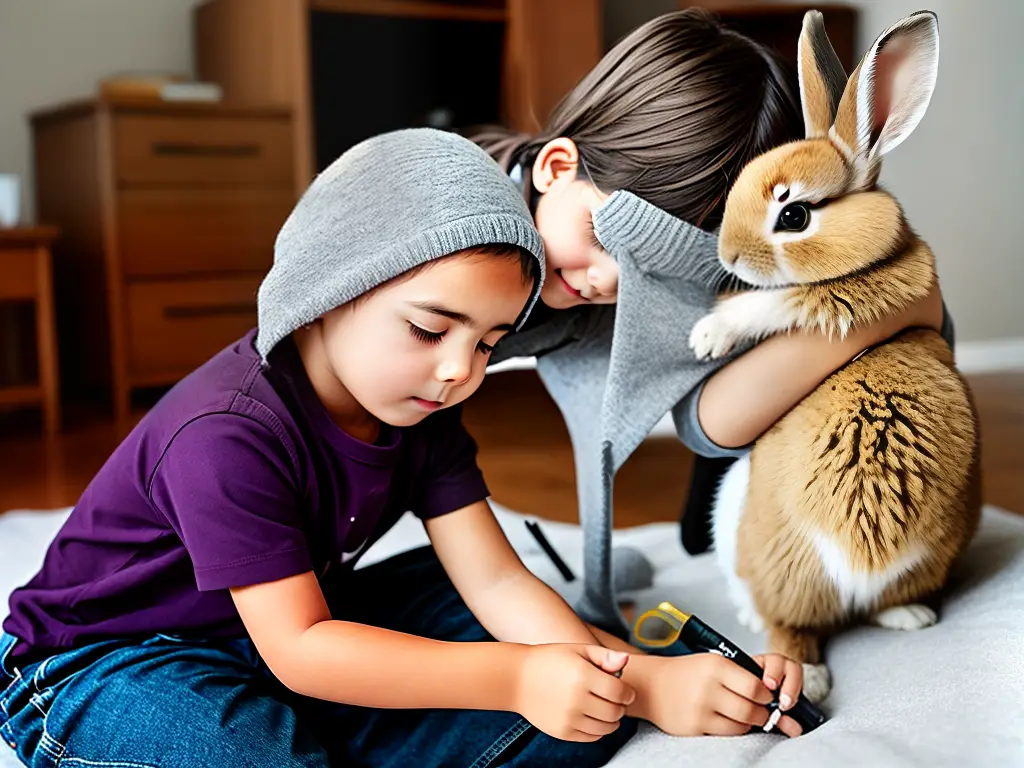
Training Your Rabbit: Fun and Useful Tips
In addition to keeping your pet rabbit in good health, engaging with them and providing mental stimulation is essential for their overall well-being. Rabbits are intelligent animals that can be trained to do simple tricks, respond to their name, and even use a litter box. Training your bunny not only provides fun activities for both of you, but it also helps create a strong bond between the two of you. One effective way to train rabbits is through positive reinforcement, which means rewarding your bunny with treats and praise every time they perform a desired behavior.
To get started, first choose a quiet and calm environment with minimal distractions. This will help your rabbit stay focused on the training. Begin by teaching your bunny to recognize their name. Say their name and when they show any sign of recognition (such as looking at you), immediately reward them with a treat and some praise. Consistency is key, and with enough repetition, your rabbit will soon start to respond to their name.
Once your rabbit has mastered responding to their name, you can start teaching them simple tricks. For example, you can train your rabbit to stand on their hind legs. Hold a treat above their head and say a command, such as ‘up.’ When your rabbit stands up to reach for the treat, reward them immediately. Remember to always be patient and take small steps during the training process. Never punish your rabbit, as this could lead to fear and a negative association with the training activities.
Litter box training is another helpful skill to teach your rabbit. To begin, place a litter box in a corner of their enclosure and add some soiled bedding to it. This will help your rabbit understand that the box is where they should do their business. Reward your rabbit with treats and praise when they use the litter box correctly. With time, patience, and positive reinforcement, your rabbit will become a well-trained and entertaining pet.

When attended to with compassion and patience, your rabbit will grow into a loving, well-mannered companion. By understanding their needs, providing a comfortable habitat, choosing the right breed, and ensuring proper handling, you’ll develop a deep and lasting friendship with your bunny. Keep in mind that taking care of a rabbit is a long-term commitment that requires dedication and responsibility. Ultimately, the joy and companionship that these furry friends offer are well worth the effort, providing a delightful and enriching experience for both child and pet.